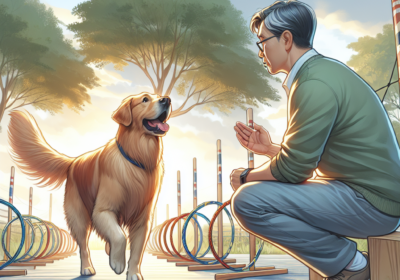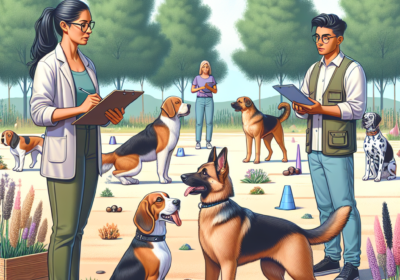The Right Age to Begin Agility Training for Dogs: A Comprehensive Overview
Are you eager to introduce your furry friend to the exciting world of agility training but unsure of when is the right time to start? Look no further! In this comprehensive guide, we will delve into the ideal age to kickstart your dog’s agility journey and provide expert tips to ensure their physical and mental readiness for this exhilarating activity.
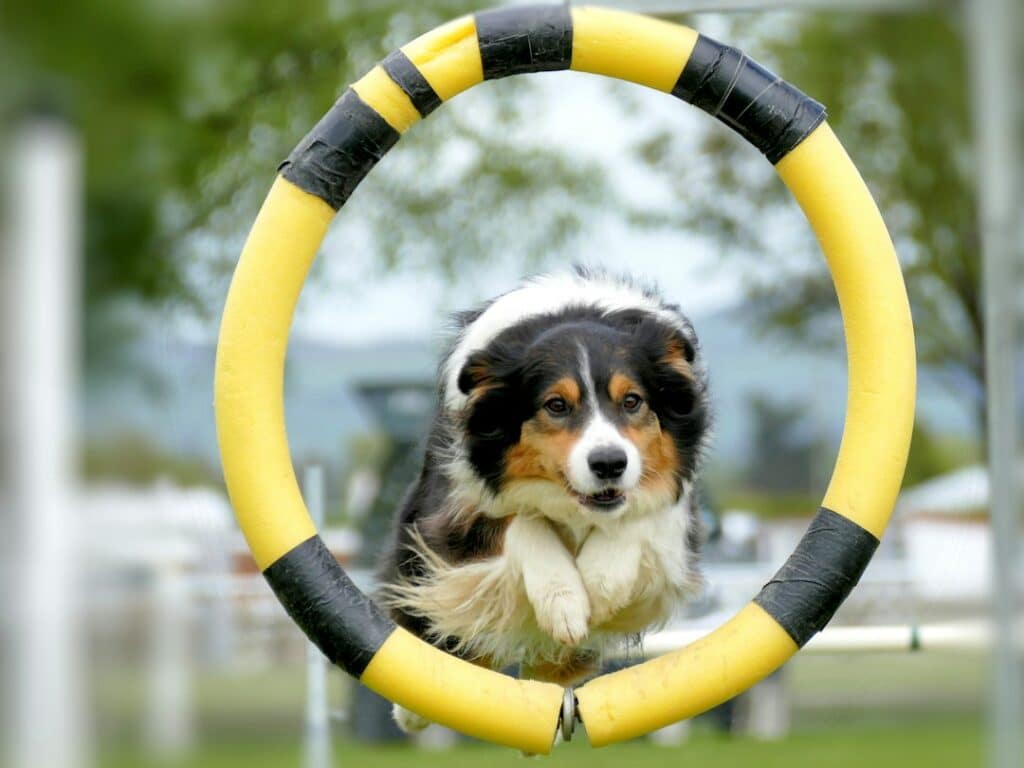
Picture this: your canine companion gracefully maneuvering through a challenging obstacle course, displaying impressive agility and focus. It’s a sight that can leave any dog owner in awe. But, before your pup can reach such heights, it’s crucial to lay a solid foundation for their training.
Throughout this blog, we’ll address the burning questions on your mind. When is it safe to introduce your dog to agility obstacles? How do you prepare a young puppy for agility training? And what about older dogs? Rest assured, we’ve got you covered.
From understanding your dog’s growth plate development to tips on building body awareness and coordination, we’ll navigate the ins and outs of dog agility training. With actionable insights and expert guidance, you’ll be equipped to make informed decisions based on your pup’s unique needs.
So, if you’re ready to embark on a fulfilling agility journey with your furry companion, let’s dive in and unlock the secrets to starting at the right age!
Introduction to Dog Agility Training
Dog agility training is a thrilling and challenging activity that involves teaching dogs to navigate an obstacle course with speed, accuracy, and precision. It is a competitive sport but can also be enjoyed as a recreational activity for dogs and their owners.
Agility training offers a wide range of benefits for dogs, both physically and mentally. It helps them improve their balance, coordination, and body awareness. By conquering various obstacles such as jumps, tunnels, weave poles, and contact equipment, dogs develop strength, flexibility, and agility. This not only enhances their overall fitness but also contributes to better joint health and muscle tone.
Moreover, agility training provides mental stimulation for dogs, keeping their minds sharp and engaged. It requires them to focus, follow instructions, and make quick decisions. This mental exercise helps prevent boredom and can address behavioral issues related to restlessness or destructive behavior.
Beyond the physical and mental benefits, agility training also strengthens the bond between dogs and their owners. It requires teamwork, communication, and trust, as handlers guide their dogs through the course using verbal cues and hand signals. This collaborative effort fosters a strong relationship and deepens the connection between the two.
Overall, dog agility training is an exciting and rewarding activity that promotes the well-being of dogs while providing them with a fun and challenging outlet for their natural abilities and instincts. Whether you aspire to compete in agility competitions or simply want to engage your dog in a stimulating activity, agility training is an excellent choice.
Next, let’s delve into the importance of the right age to begin agility training and the risks associated with starting too early or too late.
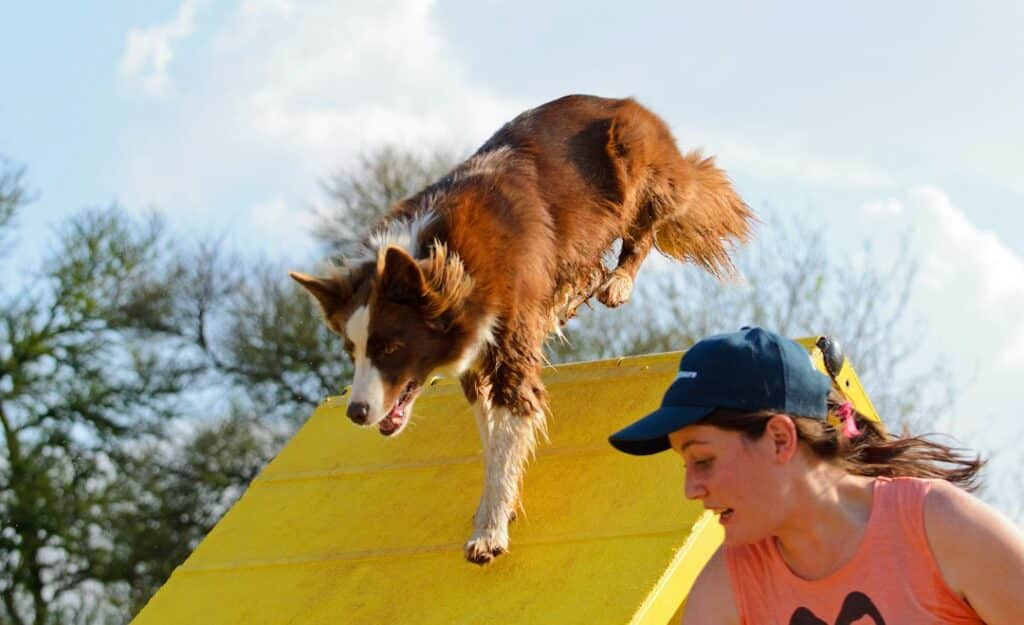
Understanding the Importance of the Right Age
When it comes to agility training for dogs, age plays a vital role in ensuring their safety, development, and long-term success. Starting agility training at the right age allows dogs to build a strong foundation while minimizing the risk of injuries and behavioral issues. Let’s delve into why age is such a critical factor and explore the potential risks of starting too early or too late.
Why Age Matters
The developmental stages of a dog directly impact their physical and mental capabilities. Starting agility training too early can strain their growing bodies and lead to injuries. On the other hand, starting too late may make it more challenging for dogs to grasp certain skills and techniques. It is essential to strike a balance and identify the optimal age to introduce your furry friend to agility training.
Risks of Starting Too Early
Puppies have delicate growth plates that are not fully developed until they reach a certain age. Intense activities like jumping and weaving can put excessive strain on these growth plates, potentially leading to growth plate injuries. Initiating agility training too early may disrupt their bone development, causing long-term issues. It is crucial to consult with a veterinarian to determine when it is safe to start agility training based on your puppy’s breed, size, and overall health.
Risks of Starting Too Late
While puppies require caution when it comes to starting agility training, waiting too long can also have drawbacks. Dogs that receive agility training during their formative years tend to develop better coordination, balance, and body awareness. Starting later in life may make it harder for dogs to adapt to the physical demands of agility obstacles. However, it’s never too late to introduce agility training, even for adult dogs. Modifications and appropriate training techniques can still help dogs of any age enjoy the sport while keeping them safe.
By understanding the potential risks associated with starting agility training too early or too late, you can make an informed decision about the right age to begin your dog’s agility journey. It is crucial to prioritize their physical and mental well-being to ensure a positive and successful training experience.
Remember, each dog is unique, and factors such as breed, size, and individual development should guide your decision. Now that we have explored the importance of age, let’s dive into expert opinions and guidelines for the suitable age to start agility training for different breeds and sizes of dogs.
Expert Opinions and Guidelines
When it comes to determining the right age to start agility training for your furry friend, opinions may vary. However, there are some general guidelines and insights from experts that can help you make an informed decision. Consider these expert opinions when deciding the suitable age to begin your dog’s agility journey.
1. Breed and Size Factors
Different breeds and sizes may have varying levels of physical and mental maturity, which can impact when they are ready for agility training. For larger breeds, it’s important to wait until their growth plates have closed and their bones have developed enough to handle the agility obstacles. According to the American Kennel Club (AKC), small dogs can start basic agility training as early as one year old, while large breeds may need to wait until they are at least 18 months old.
2. Individual Development
Each dog is unique, and their readiness for agility may depend on their individual developmental pace. Observe your dog’s physical and mental growth milestones to gauge their readiness. For example, their coordination, balance, and body awareness should be well-established before starting more complex agility exercises.
3. Exercise Balance
Agility training involves physical exertion and can put strain on a dog’s joints and muscles. Experts recommend ensuring your dog is physically fit and has a strong foundation of strength and endurance before starting agility. Regular exercise and activities like daily walks and basic obedience training can help condition your dog’s body for agility work.
4. Mindset and Temperament
Apart from physical readiness, it’s crucial to consider your dog’s mental and behavioral preparedness for agility training. They should have a good attention span, impulse control, and motivation to learn and perform agility tasks. A dog with a desire to please and the ability to focus is more likely to thrive in agility training.
5. Health and Wellness Considerations
Before embarking on agility training, it’s important to ensure your dog is in good overall health. Regular veterinarian check-ups, vaccinations, and preventive measures such as flea and tick control are essential. Consult with your vet to ensure your dog is physically and mentally fit for agility activities.
Remember, these guidelines are just a starting point, and consulting with professional trainers and instructors who specialize in agility training can provide valuable insights tailored to your specific dog’s needs. By considering expert opinions and thoroughly assessing your dog’s readiness, you can make an informed decision about the ideal age to begin their agility training journey.
> Quote: “Agility training should be a joyful and positive experience for your dog. Starting at the right age ensures their safety, physical development, and mental well-being.” – Agility Trainer
> Quote: “While it’s important to wait until the physical aspects are in place, don’t forget about the bond and trust-building that comes with agility training. Forming a strong relationship with your dog should be the foundation of your agility career together.” – Experienced Dog Owner
References:
– American Kennel Club. (n.d.). *Getting Started in Dog Agility.* Retrieved from [https://www.akc.org/sports/agility/getting-started/](https://www.akc.org/sports/agility/getting-started/)
Physical Readiness and Development
A dog’s physical readiness plays a vital role in their ability to excel in agility training. It is crucial to consider various factors that contribute to their physical development before introducing them to agility obstacles. Here are some key considerations:
Growth Plates
One of the essential aspects to consider is the growth plates in a dog’s bones. Growth plates are areas of developing cartilage that eventually turn into solid bone as the dog grows. Premature stress on these growth plates due to intense agility training can lead to growth abnormalities and potential musculoskeletal issues. Therefore, it is recommended to avoid introducing dogs to agility training until their growth plates have closed, which varies depending on the breed and size of the dog.
Bone Density
Bone density also plays a significant role in determining a dog’s physical readiness for agility training. Dogs with low bone density may be more prone to injuries when navigating through the agility course. It is crucial to ensure that their bones are strong enough to handle the impact and stress involved in agility activities. Proper nutrition, including a well-balanced diet and appropriate calcium intake, can contribute to healthy bone density.
Body Awareness
Body awareness refers to a dog’s understanding and control of their body movements. Agility training requires dogs to maneuver through obstacles, such as jumps, tunnels, and weave poles, with precision and coordination. Dogs with a good sense of body awareness are more likely to excel in agility. It is advisable to engage dogs in activities that enhance their body awareness, such as balance exercises on wobble boards or low boards. These activities help them develop proprioception and strengthen their core muscles.
Remember, every dog develops at their own pace. It is essential to consult with a veterinarian or a professional dog trainer who specializes in agility training to evaluate the physical readiness of your dog. By taking these physical factors into consideration, you can ensure a solid foundation for your dog’s agility journey and minimize the risk of injuries or long-term complications. Prioritizing your dog’s physical development will ultimately contribute to their overall fitness and longevity in the exciting world of agility.
Mental Preparedness and Behavioral Considerations
When it comes to agility training, a dog’s mental and behavioral readiness plays a crucial role in their success. Here, we delve into the key aspects of mental preparedness and behavioral considerations that determine if your furry friend is ready to embark on their agility journey.
Focus and Concentration
Agility training requires dogs to stay focused and attentive amidst various distractions. A dog with excellent focus will be able to follow your commands swiftly and navigate obstacles with precision. To assess their focus, observe if your dog can maintain attention during training sessions or engaging activities. If they easily get distracted or struggle to concentrate, additional groundwork may be necessary before introducing them to agility training.
Impulse Control
Dogs with good impulse control are better equipped to handle the fast-paced nature of agility courses. Impulse control entails the ability to resist temptations or distractions and wait for cues from their handler. This skill is crucial when they need to stop at specific obstacles, wait for instructions, or resist the urge to veer off course. Work on impulse control exercises, such as teaching your dog to wait for their food or remain calm when excited, to improve their overall self-control.
Motivation and Drive
An enthusiastic and motivated dog is more likely to excel in agility training. Dogs that display a natural drive and eagerness to learn new tasks will approach agility obstacles with enthusiasm. Look for signs of excitement, such as a wagging tail, perked ears, and a desire to engage in training sessions. If your dog lacks motivation, finding the right rewards or incentives that pique their interest can help boost their drive.
Remember that every dog is unique, and their mental and behavioral readiness may vary. While some dogs may be naturals at agility, others may need more time and training to refine these skills. It’s essential to understand and respect your dog’s individual temperament and work at their pace. By considering their mental preparedness and addressing any behavioral considerations, you’ll be setting a solid foundation for their agility journey.
> “Agility is not just about speed and physical abilities; it’s also about the mental agility and focus of the dog.” – Anonymous
Preparing Your Puppy for Agility
Preparing a puppy for agility training is a crucial step towards building a strong foundation for their agility journey. By focusing on socialization, basic obedience, and exposure to agility-related equipment, you can set them up for success. Here are some essential tips and advice to help you prepare your puppy for agility:
Socialization is Key
– Introduce your puppy to various environments, people, and other dogs from a young age. This will help them develop confidence and adaptability, crucial qualities for agility training.
– Organize puppy playdates or enroll them in puppy socialization classes to expose them to different play styles and interactions.
Basic Obedience Training
– Teach your puppy basic commands such as sit, stay, and come. These commands form the groundwork for more advanced training techniques in agility.
– Practice leash walking and recall exercises to ensure your puppy can maintain focus and follow instructions.
Exposure to Agility Equipment
– Introduce your puppy to agility-related equipment gradually. Start with basic obstacles such as tunnels, cones, and low jumps.
– Use positive reinforcement techniques such as treats and praise to create a positive association with the equipment.
Building Confidence
– Encourage your puppy to explore new environments and tackle minor challenges to build their confidence and problem-solving abilities.
– Incorporate confidence-building exercises such as balancing exercises on wobble boards or walking on different surfaces.
Remember, the emphasis in preparing a puppy for agility training is on creating a positive and enjoyable learning experience. Keep training sessions short and fun to maintain their interest and enthusiasm. As your puppy progresses, they’ll develop the necessary skills and confidence to tackle more complex agility obstacles.

Age Milestones and Age Ranges
When it comes to starting agility training for your dog, the right age is crucial to ensure their physical and mental development aligns with the demands of the sport. While each dog is unique, there are general age milestones and age ranges that can serve as a guideline.
Small and Toy Breeds: For small and toy breeds, such as Chihuahuas and Yorkies, it’s generally recommended to start agility training around 12 to 18 months of age. These dogs tend to mature earlier and can handle the physical demands of agility at a younger age.
Medium and Large Breeds: Medium and large breeds, like Labradors and Border Collies, usually have a broader age range for starting agility training. It’s advisable to wait until they are at least 12 to 24 months old, as their bodies need time to develop and strengthen.
Giant Breeds: Giant breeds, such as Great Danes and Mastiffs, have a slower growth rate compared to smaller breeds. It’s important to be cautious with these dogs and wait until they are fully grown, typically around 18 to 24 months of age, before introducing them to agility training. This allows their joints and bones to mature properly, reducing the risk of injuries.
While age is an essential factor, it’s important to consider individual development as well. Some dogs may mature earlier or later than others, even within the same breed. Pay attention to your dog’s physical development, including their bone density and overall fitness level.
Remember, agility training is a physically demanding activity that requires coordination, strength, and endurance. Starting too early can put unnecessary stress on your dog’s developing bones and joints, increasing the risk of long-term injuries. On the other hand, starting too late may hinder their ability to learn and adapt to the agility obstacles.
Consulting with a professional trainer or veterinarian who specializes in agility can provide you with personalized guidance regarding the best age to start training your dog. They can assess your dog’s individual needs, taking into account their breed, size, and overall health.
By considering age milestones and age ranges, you can ensure that your dog is physically and mentally prepared to embark on their agility journey, setting them up for success and a healthy, fulfilling agility career.
Common Misconceptions and Myths
There are several common misconceptions and myths surrounding the age requirements for agility training in dogs. It’s important to address these misconceptions and provide accurate information to ensure the best start for your furry friend. Let’s debunk some of these false beliefs:
Myth 1: Dogs Need to Be Fully Grown Before Starting Agility Training
Contrary to popular belief, dogs don’t need to be fully grown before starting agility training. In fact, starting too late may hinder their ability to learn and adapt to agility obstacles. While it’s important to consider a dog’s physical development, waiting until they are fully grown can lead to missed opportunities for early skill development and optimal conditioning.
Myth 2: Small Dogs Can’t Excel in Agility
Another common myth is that small dogs are less suited for agility training. However, small breeds like Jack Russell Terriers and Shetland Sheepdogs have proven to excel in agility competitions. With proper training and conditioning, small dogs can navigate the courses just as skillfully as their larger counterparts.
Myth 3: Only High-Energy Dogs Can Participate in Agility
Agility training is often associated with high-energy breeds like Border Collies and Australian Shepherds. However, dogs of all energy levels can benefit from and participate in agility training. The key is to tailor the training to suit the individual dog’s needs and capabilities.
Myth 4: Agility Training is Too Physically Demanding for Puppies
While puppies have developing bodies, they can still engage in age-appropriate agility training. Focusing on foundation work, such as body awareness exercises and introducing basic obstacles at a low height, can help puppies develop the skills necessary for more advanced training later on.
Myth 5: Older Dogs Cannot Start Agility Training
Many people assume that agility training is only suitable for young dogs. However, older dogs can also benefit from agility training, even if they may require some modifications and adjustments. It’s important to work at a pace that suits their individual needs and consider any physical limitations they may have.
By busting these common misconceptions and myths, you can make informed decisions about the age to start agility training for your dog. Remember that each dog is unique, and it’s essential to assess their individual capabilities and readiness.
Considerations for Older Dogs
When it comes to agility training for older dogs, there are a few important considerations and modifications to keep in mind. Age should not be a barrier to enjoying the benefits of agility, but it’s crucial to approach it with caution and prioritize the well-being of your canine companion.
Importance of Slow Progression
Slow progression is key when introducing an older dog to agility training. Their bodies may not be as resilient as they once were, so it’s essential to start with low-impact exercises and gradually increase the difficulty level. This allows their joints and muscles to adapt and reduces the risk of injury.
Joint Care and Monitoring
As dogs age, their joints become more susceptible to stiffness and inflammation. Before embarking on agility training, it’s wise to consult with a veterinarian to ensure your dog’s joints are healthy enough to handle the physical demands. Incorporating joint supplements or anti-inflammatory medications, as advised by your vet, can help support their joint health during training.
Gentle Warm-up and Cool-down
Prior to each training session, spend a few minutes gently warming up your older dog’s muscles and joints. This can be done through light exercises such as walking or slow trotting. Additionally, make sure to include a proper cool-down period after training to help prevent muscle soreness and reduce the risk of injury.
Modified Obstacles and Routines
Consider modifying agility obstacles and routines to accommodate the physical limitations of older dogs. Lowering jumps, reducing contact obstacle heights, or using wider tunnels can help minimize stress on their bodies. Introduce simpler versions of the obstacles to help build confidence and gradually progress as they gain strength and agility.
Regular Rest and Recovery
Older dogs may need more time to rest and recover between training sessions. Avoid overexertion and provide ample opportunities for rest and relaxation. Adequate rest will help prevent fatigue and ensure that your dog is ready for each training session.
Remember, agility training for older dogs is not just about competition but also about mental stimulation and maintaining a healthy lifestyle. Always monitor your dog’s behavior and well-being during training, and adjust the intensity or frequency of sessions as needed. With proper care and consideration, older dogs can still enjoy the thrill of agility while staying safe and healthy.

Safety Guidelines and Equipment
When it comes to agility training for your dog, safety should be your top priority. By following these guidelines and using the right equipment, you can ensure a safe and enjoyable experience for both you and your furry friend.
Safety Guidelines
1. Warm-up and cooldown: Always start with a warm-up routine to prepare your dog’s muscles and joints for physical activity. Similarly, end each session with a cooldown routine to help prevent any post-training stiffness.
2. Proper warm-up exercises: Engage your dog in gentle activities such as walking or light jogging to warm up their muscles gradually. This will reduce the risk of strains or sprains during agility training.
3. Use positive reinforcement: Encourage and reward your dog for their efforts, using treats, praise, or their favorite toys. Positive reinforcement helps create a positive association with agility training and motivates your dog to participate willingly.
4. Gradual progression: Start with simple obstacles and gradually increase the complexity and difficulty. Avoid pushing your dog too hard or too fast, as it may lead to injuries or overwhelm them. Take it one step at a time to ensure a safe and smooth progression.
Recommended Equipment
1. Safety harness or collar: Use a well-fitted and secure harness or collar to ensure your dog’s safety during agility training. This will provide you with control while allowing your dog to move comfortably.
2. Non-slip contact surfaces: Make sure that contact surfaces, such as the dog walk or A-frame, have a non-slip surface to prevent accidents or injury. Secure the equipment properly to avoid any wobbling.
3. Standard-sized equipment: Use agility equipment that is appropriate for your dog’s size and age. This will help minimize unnecessary strain on their muscles and joints.
4. Safety tunnels: Ensure that tunnels have a rigid structure to prevent collapses during your dog’s passage. Opt for sturdy tunnels made specifically for agility training.
Remember, agility training should always be performed under the supervision of a trained professional or experienced agility instructor. By following these safety guidelines and using the right equipment, you can create a safe and enjoyable environment for your dog’s agility journey.
Agility Training for Dogs: When is the Right Time to Begin? >
Final Thoughts
In closing, starting agility training for your dog at the right age is crucial for their physical and mental development. By considering their individual needs and following expert guidelines, you can set a strong foundation for their agility journey.
Throughout this comprehensive guide, we have explored the key aspects of age-related considerations in dog agility training. Here are the main takeaways:
1. Age Milestones and Age Ranges: Different factors such as breed, size, and individual development play a role in determining the optimal age to start agility training. It is important to consider both physical and mental readiness.
2. Physical Readiness: Ensure that your dog’s growth plates are closed, bone density is appropriate, and body awareness is well-developed. This helps prevent injuries and supports their overall health.
3. Mental Preparedness: Mental factors such as focus, impulse control, and motivation are essential for successful agility training. Training sessions should be enjoyable and rewarding for your dog.
4. Preparing Your Puppy: Prioritize socialization, basic obedience, and exposure to agility-related equipment during your puppy’s early months. This helps them build confidence and prepares them for agility training in the future.
Remember, every dog is unique, and it’s important to tailor their training journey based on their specific needs. Safety should always be a top priority, and gradual progression is key, especially for older dogs. By following these guidelines and considering your dog’s individual readiness, you can help them embark on a rewarding agility career and live a healthy life.
So go ahead, start planning your dog’s agility training, and enjoy the wonderful bond that forms through this engaging and stimulating activity. Happy training!





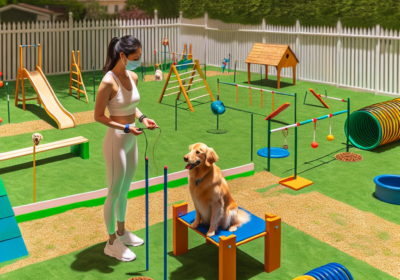
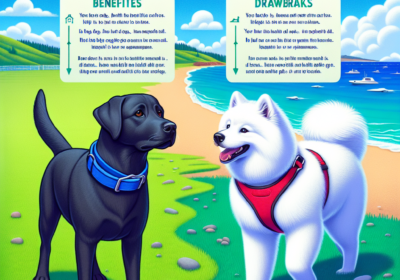
![The Dog Podcast Uncovers Startling Truths About What We Feed Our Dogs [Press Release]](https://yourhomeandgardenhub.com.au/wp-content/uploads/2024/08/dog-bowl-400x280.webp)
